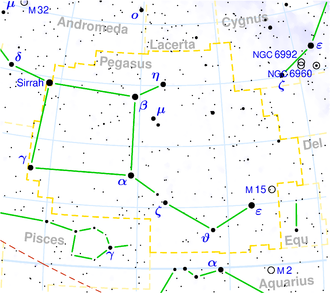NGC 7467
| Galaxy NGC 7467 |
|
|---|---|

|
|
| SDSS recording | |
| AladinLite | |
| Constellation | Pegasus |
|
Position equinox : J2000.0 , epoch : J2000.0 |
|
| Right ascension | 23 h 02 m 27.5 s |
| declination | + 15 ° 33 ′ 15 ″ |
| Appearance | |
| Morphological type | cE |
| Brightness (visual) | 14.5 mag |
| Brightness (B-band) | 15.5 mag |
| Angular expansion | 0.40 x 0.3 |
| Position angle | 33 ° |
| Surface brightness | 12.3 mag / arcmin² |
| Physical data | |
| Redshift | 0.038106 |
| Radial velocity | 11424 km / s |
|
Stroke distance v rad / H 0 |
(518 ± 36) · 10 6 Lj (158.9 ± 11.1) Mpc |
| history | |
| discovery | Albert Marth |
| Discovery date | October 23, 1864 |
| Catalog names | |
| NGC 7467 • PGC 70310 • CGCG 430-053 • MCG + 02-58-057 • 2MASX J23022748 + 1533145 • NSA 150509 | |
NGC 7467 is a compact elliptical galaxy of the Hubble-type cE in the constellation Pegasus in the northern sky . It is estimated to be 518 million light years away from the Milky Way and has a diameter of about 60,000 ly.
In the same area of the sky are the galaxies NGC 7461 , NGC 7463 , NGC 7464 , NGC 7465 , among others .
The object was discovered by Albert Marth on October 23, 1864 .
